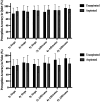Consonant aspiration in Mandarin-speaking children: a developmental perspective from perception and production
- PMID: 39882208
- PMCID: PMC11776868
- DOI: 10.3389/fped.2024.1465454
Consonant aspiration in Mandarin-speaking children: a developmental perspective from perception and production
Abstract
Introduction: This study investigates Mandarin-speaking children's acquisition of aspirated/unaspirated voiceless consonants in terms of perception and production, to track children's developmental profile and explore the factors that may affect their acquisition, as well as the possible association between perception and production.
Methods: Mandarin-speaking children (N = 95) aged 3-5 and adults (N = 20) participated in (1) a perception test designed based on the minimal pairs of unaspirated/aspirated consonants in the quiet and noisy conditions respectively; (2) a production test where participants produced the target words, with syllable-initial consonants focusing on aspiration and non-aspiration. Six pairs of unaspirated/aspirated consonants in Mandarin were included.
Results: (1) Children's perception and production accuracy of aspirated and unaspirated consonants increased with age. Five-year-olds achieved high accuracy in the perception under the quiet condition and in the production (over 90%), though not yet adult-like. (2) Noise adversely affected children's perception, with all child groups showing poor performance in the noisy condition. In terms of perception, stops were more challenging to children than affricates, but in terms of production, children performed better on stops. Furthermore, the presence of noise had a greater detrimental effect on the perception of aspirated consonants compared to unaspirated ones. (3) A weak positive correlation was found between children's perception of consonant aspiration in the quiet condition and their production.
Discussion: The findings indicate that age, aspiration state, and manner of articulation (MOA) would affect children's acquisition of consonant aspiration. Although 5-year-olds have almost acquired aspirated/unaspirated consonants, compared to adults, the perception of consonant aspiration in noise remains a challenge for children.
Keywords: Mandarin; child development; consonant aspiration; perception; production.
© 2025 Li, Li, Du, Wang, Li, Wen and Zheng.
Conflict of interest statement
The authors declare that the research was conducted in the absence of any commercial or financial relationships that could be construed as a potential conflict of interest.
Figures







Similar articles
-
[Perception of Mandarin aspirated/unaspirated consonants in children with cochlear implants].Lin Chuang Er Bi Yan Hou Tou Jing Wai Ke Za Zhi. 2025 Apr;39(4):312-318. doi: 10.13201/j.issn.2096-7993.2025.04.004. Lin Chuang Er Bi Yan Hou Tou Jing Wai Ke Za Zhi. 2025. PMID: 40166871 Free PMC article. Chinese.
-
Acquisition profiles of syllable-initial consonants in Mandarin-speaking children with cochlear implants.Acta Otolaryngol. 2003 Dec;123(9):1046-53. doi: 10.1080/00016480410016171. Acta Otolaryngol. 2003. PMID: 14710906
-
Discrimination of consonants in quiet and in noise in Mandarin-speaking children with normal hearing.PLoS One. 2023 Mar 21;18(3):e0283198. doi: 10.1371/journal.pone.0283198. eCollection 2023. PLoS One. 2023. PMID: 36943841 Free PMC article.
-
Children's Consonant Acquisition in 27 Languages: A Cross-Linguistic Review.Am J Speech Lang Pathol. 2018 Nov 21;27(4):1546-1571. doi: 10.1044/2018_AJSLP-17-0100. Am J Speech Lang Pathol. 2018. PMID: 30177993
-
Children's English Consonant Acquisition in the United States: A Review.Am J Speech Lang Pathol. 2020 Nov 12;29(4):2155-2169. doi: 10.1044/2020_AJSLP-19-00168. Epub 2020 Jul 21. Am J Speech Lang Pathol. 2020. PMID: 33181047 Review.
References
-
- Lisker L, Abramson AS. A cross-language study of voicing in initial stops: acoustical measurements. Word. (1964) 20:384–422. 10.1080/00437956.1964.11659830 - DOI
-
- Hanson HM, Stevens KN. Models of aspirated stops in English. In: Solé MJ, Recasens D, Romero J, editors. Proceedings of the 15th International Congress of Phonetic Sciences (ICPhS-15). Barcelona, Spain: International Phonetic Association; (2003). p. 783–6. ISBN 1-876346-48-5.
LinkOut - more resources
Full Text Sources

